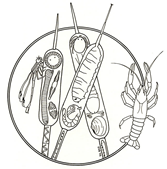Crevices as refuges
[skip introduction and go to research project list]
Stream stones are often rounded and seem fairly smooth, but magnification of the surface reveals roughness.
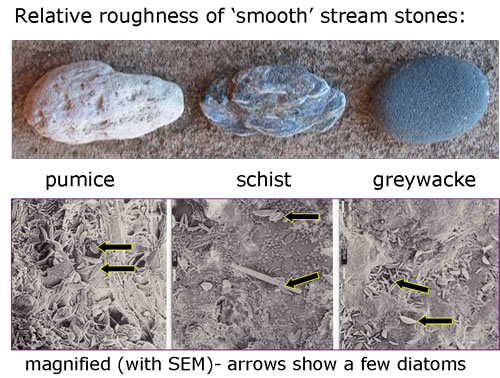
This surface roughness includes crevices that can protect small algae (see the diatoms in the pictures above) from insect and fish grazers, and from floods. As an analogy, it’s hard to brush dirt out of grooves (crevices) in the bottoms of tennis shoes - the dirt is protected.
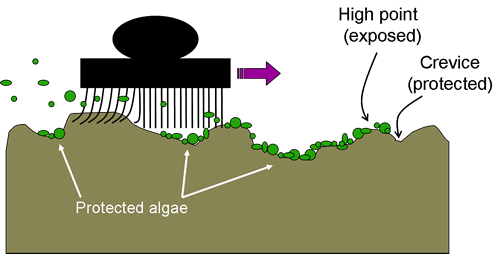
Diagram demonstrating how algae are protected in crevices of stream stones. The brush acts like grazers or floods, leaving most of the algae in crevices and removing most of the algae on the high points. (Think of brushing dirt stuck on the bottom of shoes!)
The protected algae in crevices can survive grazing and floods and then grow out of the crevices and colonize the rest of the stone and other surfaces, which probably provides algal food for grazers.
We are studying how well crevices protect algae growing on streambed stones and how this protected algae affects the ecology of a stream.Why study stream algae, particularly diatoms?
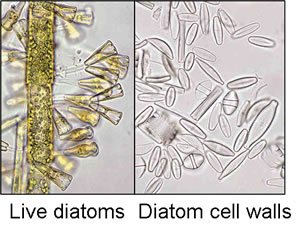 There are several groups of stream algae, including mats of filamentous green algae, clumps of cyanobacteria, and thin films of diatoms. Diatoms are very common, but are too small to see without magnifiication. They are ordinarily recognizable as the golden brown, slippery coating on stream stones.
There are several groups of stream algae, including mats of filamentous green algae, clumps of cyanobacteria, and thin films of diatoms. Diatoms are very common, but are too small to see without magnifiication. They are ordinarily recognizable as the golden brown, slippery coating on stream stones.
Diatoms are characterized by beautiful glass cell walls, made of two overlapping halves. Most diatoms occur as single cells, but some form filamentous or clump-like colonies.

Because they store energy as oil, diatoms are highly nutritious for stream grazers. Consequently, diatoms contribute to the base of the streamfood web (a diagram of who eats who). Grazers such as snails, some insects and a few fish eat diatoms and are, in turn, eaten by predators (predaceous insects and fish).
Diatoms are also abundant in lakes and the oceans; indeed, approximately 20% of the world's productivity has been attributed to diatoms (David Mann, p. 438 in 'The species concept in diatoms; Phycologia 38; 1999).
Diagram at right: A simplified stream food web, with several species of diatoms at the base and bass at the top. Arrows show the direction of energy flow and point from the food to the consumer (e.g., arrows from diatoms point to grazers).
The protection of diatoms in crevices can increase the food available at the base of the food web, which may increase number of grazers and even the amount of fish supported in a stream.
Here is a list of some of our crevices-related research projects, followed by short summaries:
Relationship between rock roughness and algal availability.
[back to top] [back to crevices research project list] [research home] [home]
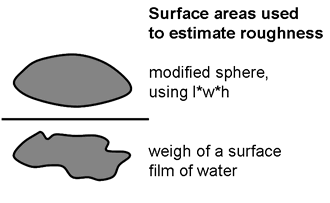 Previous methods used to estimate rock roughness required lots of effort and/or speciallized equipment. We developed a method that is easy, cheap, and uses the entire rock's surface.
Previous methods used to estimate rock roughness required lots of effort and/or speciallized equipment. We developed a method that is easy, cheap, and uses the entire rock's surface.
In short, our method entails finding the ratio between two surface area measurements: the first based on the equation for the surafce area of a sphere, but using three different diameter measurements (length, width, height) and the second based on the weight of a film of water coating the stone surface (i.e., by weighing the dry stone, dipping it in a water-soap solution, and reweighing; the weight gain indicates surface area).
The 'roughness ratio' indicates relative roughness AND porosity.
Publications:
Bergey, E. A. and G. M. Getty. 2006. A review of methods for measuring the surface area of stream substrates. Hydrobiologia 556: 7-16.
Bergey, E. A. 2006. Measuring the surface roughness of stream stones. Hydrobiologia 563: 247-252.
[back to top] [back to crevices research project list] [research home] [home]
Relationship of rock roughness and algal availability
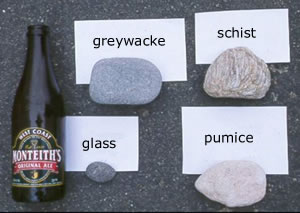 We wanted to test how much algal were on the surface versus in crevices on rocks. We selected substrates with different roughness - three stream rocks (greywacke, schist, and pumice) and also used glass bottles, a very smooth surface. Substrates were submerged in a springbrook. After waiting for algae to grow, algae were scrubbed off rocks (= removed algae). Both the removed algae and algae remaining with the substrates were quantified by extracting and measuring chlorophyll a concentrations.
We wanted to test how much algal were on the surface versus in crevices on rocks. We selected substrates with different roughness - three stream rocks (greywacke, schist, and pumice) and also used glass bottles, a very smooth surface. Substrates were submerged in a springbrook. After waiting for algae to grow, algae were scrubbed off rocks (= removed algae). Both the removed algae and algae remaining with the substrates were quantified by extracting and measuring chlorophyll a concentrations.

Note: This experiment was done in New Zealand where some streams really do have pumice substrates!
Here's what we found: (also see the graph)
1. The total amount of algae increased with substrate roughness.
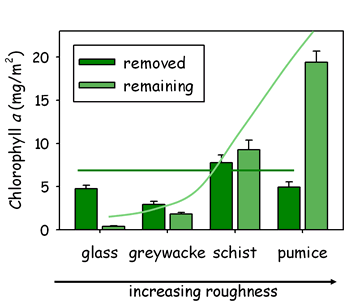 2. The amount of algae removed with scrubbing (= removed algae; dark green bars and line on graph) was similar among the substrates (although schist had a slightly higher amount of algae). This may indicate that grazers limit these exposed algae.
2. The amount of algae removed with scrubbing (= removed algae; dark green bars and line on graph) was similar among the substrates (although schist had a slightly higher amount of algae). This may indicate that grazers limit these exposed algae.
3. As substrate roughness increased, the amount of remaining (hidden) algae increased (light green bars and line in the graph). This may indicate that grazers cannot reach these algae within crevices.
Publication:
Bergey, E. A. 2005. How protective are refuges? Quantifying algal protection in rock crevices. Freshwater Biology 50: 1163-1177.
[back to top] [back to crevices research project list] [research home] [home]
Both diatoms and rock crevices vary in size. Crevices that are smaller than diatoms will not provide protection; crevices that are very large will not exclude grazers. But what size crevice is optimal for diatom protection?

To test whether crevice size mattered, we made sets of clay substrates with different sizes of crevice depressions. (First we made molds by gluing hemispherical objects on a flat surface; then pressed 'clay patties' onto the molds to make uniform crevices. The clay patties were fired after drying.
We used large plastic aquaculture pools, inoculated with algae scrubbed for stream stones. After algae were growing on the clay substrates, we added fish - using algae-feeding central stonerollers (Cyprinidae: Campostoma anomalum). Fish were allowed full access to clay substrates, were caged away from substrates, or were allowed access through partial cages (to test whether the cages, themselves, had an effect).

The central stonerollers ate the algae on the tops of flat, creviceless substrates (black arrow, above). On creviced substrates, small crevices (less than 2 mm in diameter) contained lots of algae (red arrow, above), but larger crevices did not (yellow and orange arrows, above). Algae in these larger crevices were grazed by the fish.
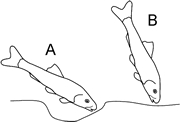 Indeed, fish grazed algae within larger crevices more than on the adjacent flat surfaces - probably because of the 'angle of attack' (i.e., the angle of feeding in 'A' is probably preferable to the angle in 'B').
Indeed, fish grazed algae within larger crevices more than on the adjacent flat surfaces - probably because of the 'angle of attack' (i.e., the angle of feeding in 'A' is probably preferable to the angle in 'B').
Conclusions:
Crevice size matters, but the critical dimensions depend on the sizes of the contained organisms (e.g., diatoms) and the size of the grazers (e.g., central stonerollers). Small crevices are protective; large crevices are not because they do not exclude grazing.
An earlier experiment demonstrated that VERY small crevices protect only small species of diatoms, resulting in low species diversity in these crevices, whereas larger - though still small crevices - protected a diverse assemblage of diatoms.
Publications:
Bergey, E. A. and J. E. Weaver. 2004. The influence of crevice size on the protection of epilithic algae from grazers. Freshwater Biology 49: 1014-1025.
Bergey, E. A. 1999. Crevices as refugia for stream diatoms: Effect of crevice size on abraded substrates. Limnology and Oceanography 44: 1522-1529.
[back to top] [back to crevices research project list] [research home] [home]
Do different rocks 'grow' different algae?
Rocks have different roughness, but they also have different chemistries. Algae, like vascular plants, require nutrients and a variety of minerals for growth and reproduction. Thus, it seems likely that the variation in mineral composition among rocks can lead to differences in the growth of attached algae. Because rock roughness also varies among rock types, separating the effects of rock roughness and rock chemistry was problematic.
To distinguish effects of rock chemistry from effects of rock roughness, we pulverized rocks (with loss of roughness), incorporated the powdered rock into agar, and placed the experiment in a stream, where algae colonized a permeable film over the rock-agar mixture. We also put out nutrient agar to check for differences of algal growth with the addition of nitrogen, phosphorus, and combined nitrogen and phosphorus with a no-added nutrient control.
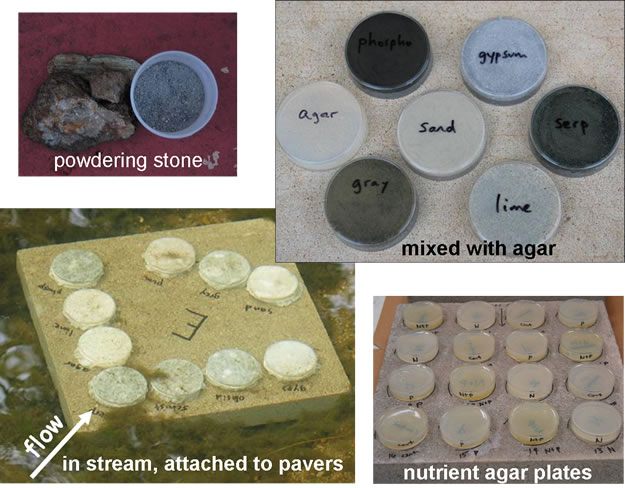
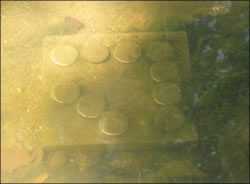
There was no consistent difference in the amount of algae colonizing the different rocks (green-bar graph, below). That is, rock chemistry had very little or no effect on that attached algae. In contrast, we found difference in the amount of algae among the eight stream sites (graph not shown), and among the different nutrient treatments (algae were both phosphorus and nitrogen limited; purple-bar graph, below).
Conclusion:
Chemical composition of rocks has little effect on attached algae. Rock chemistry probably has greater effect through groundwater sources, because groundwater is in contact with rocks for long periods of time, with resultant dissolution of rock chemicals.
In contrast to rocks, nutrients readily diffusee out of the agar solution and can be taken up by algae in dissolved form.

Publication:
Bergey E. A. 2008. Does rock chemistry affect periphyton accrual in streams? Hydrobiologia 614: 141-150.
[back to top] [back to crevices research project list] [research home] [home]
Survey of rocks and algae in high Rocky Mountain streams
In this survey we documented the variation in rock roughness in streams that results from mixtures of rock types. We surveyed 12 high mountain streams in the Colorado and Wyoming portions of the Rocky Mountains. We measured a number of variables and will use path analysis to indicate which variables affect the amount of algae in the streams.
Here are the types of data that we collected:
- a survey of the types and sizes of rocks
- discharge, water velocites and depths (e,g, How much water is there?)
- the amount of algae on each rock type (including both removed and remaining algae)
- algal taxonomic composition on the various rocks
- nutrient levels
- shade by riparian vegetation
- productivity (amount of photosynthesis) for algae on selected rock types.
- the invertebrates living in the stream bed (some graze algae)
This project is in progress.
[back to top] [back to crevices research project list] [research home] [home]
